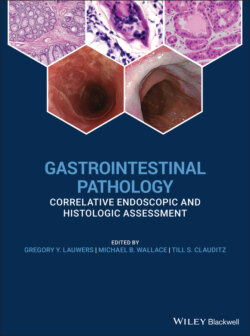Читать книгу Gastrointestinal Pathology - Группа авторов - Страница 98
Dermatological Diseases Involving the Esophagus Definition, General Features, Predisposing Factors
ОглавлениеThe esophagus may be involved in multiple primary dermatologic conditions (Table 2.8). Esophageal manifestation may develop in the presence or absence of skin lesions. As these disorders are generally not well recognized by both gastroenterologists and pathologists, they may be overlooked for some time and the diagnosis delayed with potentially important consequences.
Table 2.8 Dermatologic diseases involving the esophagus.
| Lichen planus |
| Bullous diseases |
| Pemphigus vulgaris |
| Bullous pemphigoid |
| Epidermolysis bullosa acquisita |
| Behcet’s syndrome |
| Toxic epidermal necrolysis/Stevens–Johnson syndrome |
| Scleroderma |
Lichen planus involving the esophagus is rare and can occur in conjunction with other mucosal (or cutaneous) lesions or as the sole manifestation. It is predominantly seen in middle‐aged women. Oral involvement coexists with skin lesions in approximately 30–50% of patients. Lichenoid esophagitis refers to a subset of patients with an identical lichen planus pattern of histologic injury without oral or cutaneous lesions, negative immunofluorescence studies and some distinct demographics, such as polypharmacy and an association with viral hepatitis or HIV.
The bullous diseases are also difficult to diagnose in the esophagus and correlation of the findings with the clinical manifestations, separate biopsies of the skin lesions, and ancillary immunofluorescence studies can help secure the diagnosis. Pemphigus vulgaris is the most common of the autoimmune mucocutaneous diseases with bulla formation. Men and women are affected equally, with a predominance of middle‐aged to elderly individuals, although often asymptomatic, esophageal involvement can be demonstrated in the majority of patients if sought by endoscopy and biopsy. Pemphigus vulgaris is caused by loss of integrity of the normal intercellular attachments within the mucosal epithelium resulting in intramucosal bullae of various sizes. Although esophageal involvement may be a frequent occurrence in active mucocutaneous disease, it may also rarely occur as the sole or initial manifestation.
Bullous pemphigoid is a chronic, immune‐mediated, subepidermal blistering skin disease that rarely involves mucosal surfaces and affects the esophagus less commonly than pemphigus vulgaris. It primarily affects patients in the fifth through seventh decades.
Epidermolysis bullosa is a diverse group of inherited skin disorders caused by mutations of genes that encode for structural proteins located at the dermal‐epidermal junction. The patients characteristically develop blisters after minor trauma, with a range of clinical phenotypes and severity. Minor trauma from a food bolus may elicit similar esophageal mucosal injury.
There are also rare reports of Behcet’s disease involving the esophagus, ranging from asymptomatic to severe stricturing disease. In scleroderma, dysmotility‐associated esophageal inflammatory injury is due primarily to reflux and/or candidiasis.
